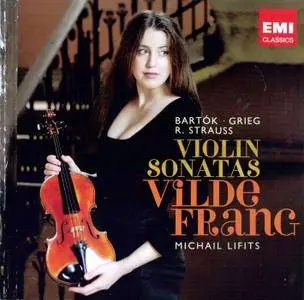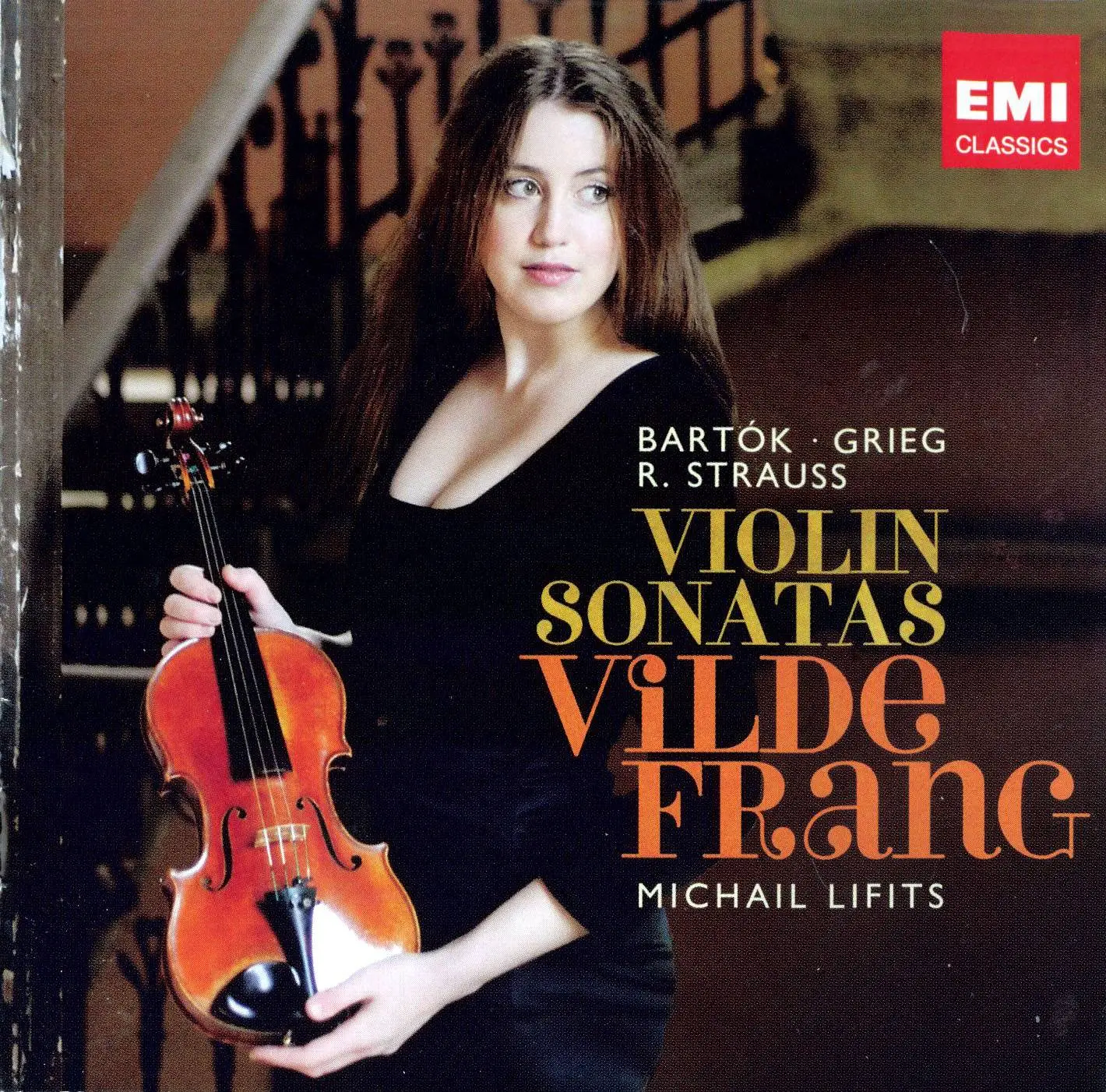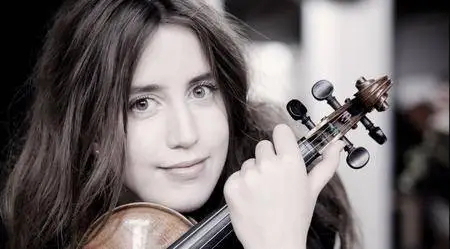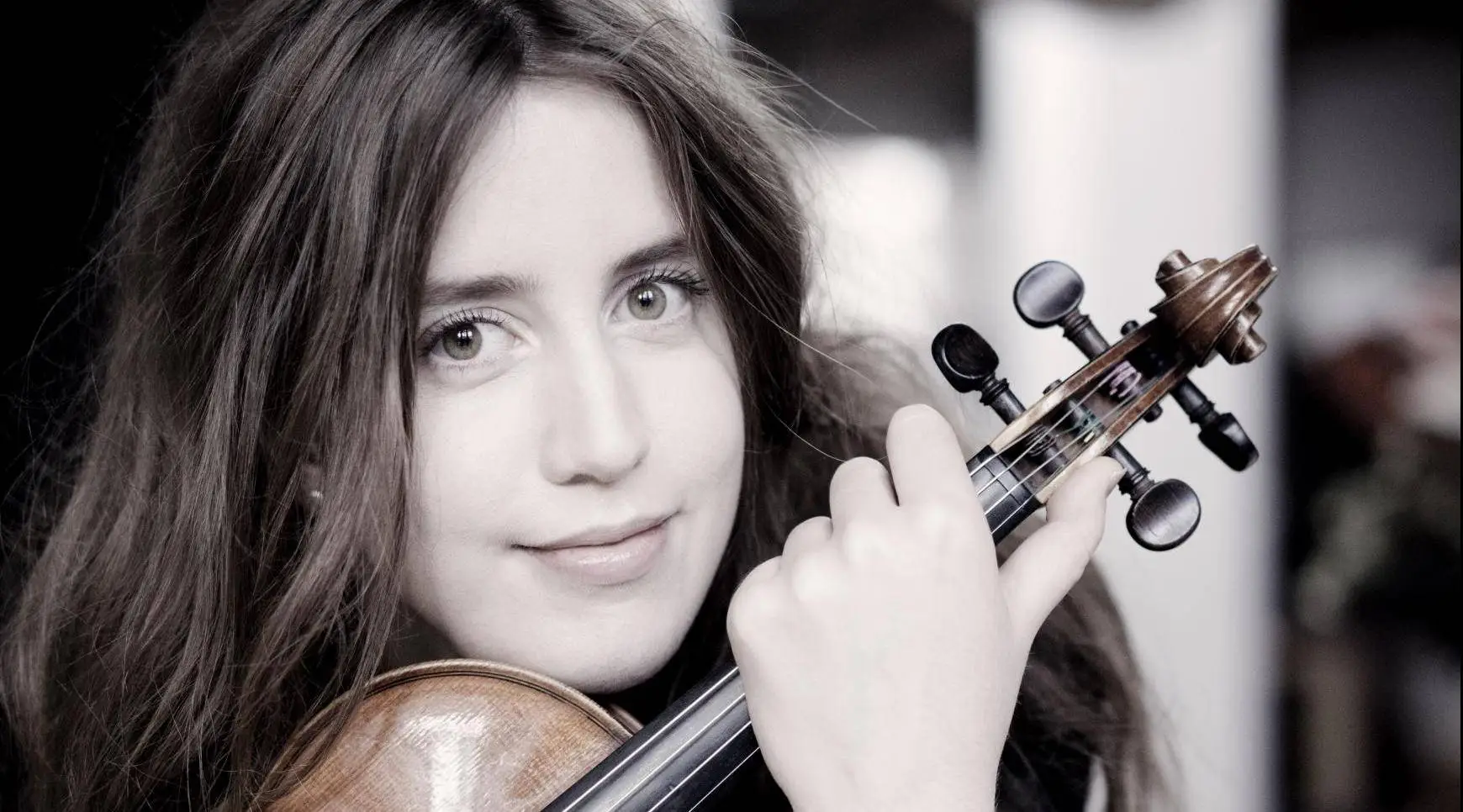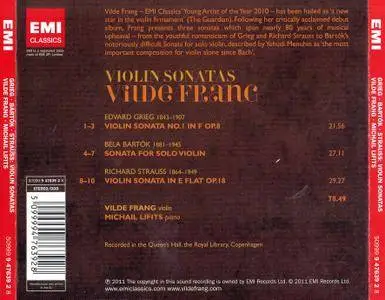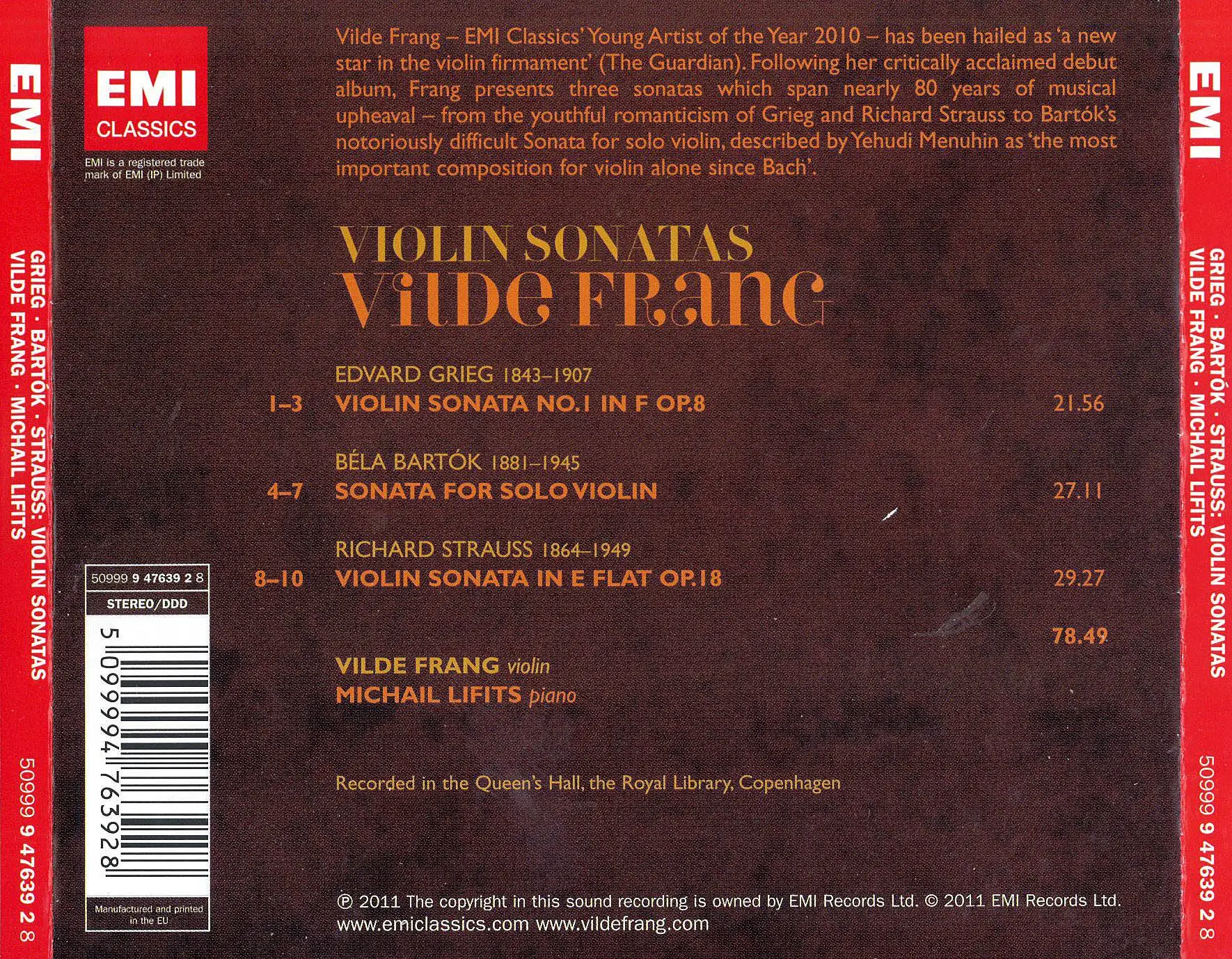Béla Bartók, Edvard Grieg, Richard Strauss: Violin Sonatas (2011)
Vilde Frang (violin), Michail Lifits (piano)
EAC | FLAC | Image (Cue&Log) ~ 321 Mb | Mp3 (CBR320) ~ 188 Mb | Scans included
Classical | Label: EMI Classics | # 50999 9 47639 2 8 | Time: 01:18:50
Vilde Frang (violin), Michail Lifits (piano)
EAC | FLAC | Image (Cue&Log) ~ 321 Mb | Mp3 (CBR320) ~ 188 Mb | Scans included
Classical | Label: EMI Classics | # 50999 9 47639 2 8 | Time: 01:18:50
One of the leading young soloists to emerge from Scandinavia in recent years, noted particularly for her superb musical expression, as well as her well-developed virtuosity and musicality. Young Norwegian violinist, Vilde Frang brings together a diverse, yet complimentary selection of sonatas for her second EMI Classics release. The youthful, spirited Grieg: Violin Sonata No.1 in F Major, Op. 8 and Richard Strauss: Violin Sonata in E-flat Major, Op. 18 are paired with Bartók’s technically challenging, musically complex Sonata for Solo Violin, BB 124, Sz. 117. Frang frequently performs the later, which Bartók composed as an homage to Bach, with the Strauss in concert. Vilde is joined by pianist Michail Lifits for this recording.
Those who’ve heard Vilde Frang’s EMI recording of Sibelius and Prokofiev concertos (4/10) will be keen to sample this. For the duo sonatas she’s teamed with a pianist who shares her perceptive musicianship – an ability to find the right shape for every phrase – as well as her polished technique. I always associate the Strauss Sonata with Heifetz’s ardent, sensuous interpretation. Frang, however, is in her own way just as persuasive; if there are a few moments where we feel she is too restrained, it’s soon clear that it’s in order to bring into relief a subsequent, more passionate section. Though Frang’s tone generally appears quite light and silvery, she has ample reserves, and none of the climactic moments disappoint. Lifits, too, finds a wonderful, brooding sonority for the finale’s introduction, before bursting forth, Don Juan-like, at the Allegro.
They perform the Grieg quite freely, not always observing the expression marks, and Frang (very effectively) adds chords in the second movement. This is a remarkably fresh, imaginative account, with Lifits relishing Grieg’s unconventional harmony.
In the Bartók I was immediately struck by Frang’s fine rhythmic sense and varied tonal palette. Her playing has the necessary physicality for Bartók, without ever appearing forced. She characterises the different motifs in the Fuga sharply and, in the third movement, moves compellingly through the long melody. I’m not convinced by the sul ponticello start to the finale (my score just has con sord), but overall it’s a top-class performance and, indeed, the whole programme is clearly a winner.Review by Duncan Druce, Gramophone
RECORDING OF THE MONTH:
Like so many other world-class violinists Vilde Frang started taking lessons very early and was invited by Mariss Jansons to make her debut with the Oslo Philharmonic Orchestra at the age of twelve. I heard her some years ago playing Prokofiev’s second concerto and was amazed, not only by her impeccable technique - which is something one takes for granted nowadays - but for her innate musicality and sense of style. Her debut disc for EMI with the Sibelius and Prokofiev’s first concerto received glowing reviews (review review) and this new disc only confirms that impression.
The programme is quite unusual. Do these composers have anything in common? Well, in fact they have. Grieg and Strauss were both fairly young when they composed their sonatas, Grieg was 22 and Strauss barely a year older. In both cases it is youthful, somewhat turgid music, full of vitality and promising well for their future. Grieg and Bartók have their folk music background in common, clearly discernible in both their works. Even though the link between Strauss and Bartók is weaker, it was when Bartók heard the Budapest premiere of Also sprach Zarathustra in 1902 that he decided to devote his life to composing.
The Grieg sonata flows with youthful freshness in the first movement with a Norwegian touch. The Norwegian element is far more assertive in the down-to-earth fiddling dance of the second movement, where Frang is tremendously assured and rhythmically alert. The third movement is full of thematic ideas and whirls forth with infectious flair. It’s a brilliant conclusion to an utterly stimulating work. The third sonata, more formally rounded, may be a greater master-piece but here, already, Grieg very distinctly shows his mettle.
With the Bartók sonata we move to a quite different world. Commissioned by Yehudi Menuhin and completed in March 1944 it is one of the composer’s last works. There are dissonances aplenty but also passages of immense beauty. The fugue is certainly tricky but fresher and more lively than most fugues. Balm is offered in abundance in the third movement, Melodia, which opens with a phrase that evokes memories of the slow movement of Brahms’ Double Concerto. Then it wanders down its own path - and very beautiful it is alternating brittle woodwind and rounded cello-deep melodies. The finale is the folk-dance equivalent of the Grieg sonata’s second movement, only even more uninhibited and unpredictable. The folk-music roots are never far away in Bartók’s music.
The first movement of Strauss’s sonata has the same exuberance as Grieg’s and an even more elaborate piano part. It’s the work of a young romantic where the blood pulsates wildly. The simplicity of the second movement is only temporary. Soon the music storms away, only to give way for what the title of the movement suggests: an elegant improvisatory excursion over arpeggio chords in the piano. The sombre opening of the finale is also a smoke-screen: this soon disperses and we are exposed to jolly caprices as well as a broad romantic canvas, painted with powerful brush-strokes.
Vilde Frang’s playing is overwhelming, natural, fluent and flexible. I wouldn’t say that charm is the first word that comes to mind when talking of Bartók’s solo sonata but Ms Frang’s playing has that elusive quality in whatever she approaches. Menuhin wrote in his autobiography, quoted in the liner-notes by David Nice: ‘when I saw it … I admit I was shaken, it seemed to me almost unplayable’ If ever Vilde Frang had similar thoughts there is not a trace of it. I have not made any comparisons for this review, simply because this coupling is, as far as I have been able to find out, unavailable anywhere else. But from the very first bars of the Grieg sonata and throughout this very well-filled disc, there is no doubt that we are listening to a master violinist. Michail Lifits at the piano seems to be her twin soul. With recorded sound out of EMI’s most exalted drawer this is a disc that goes to the top-ten-list of violin recordings. Give us more of Vilde Frang, please, EMI!Review by Göran Forsling, MusicWeb-International.com
Following her successful debut album of violin concertos by Jean Sibelius and Sergey Prokofiev, Vilde Frang turns to chamber music for her second release on EMI, in a program of violin sonatas by Edvard Grieg, Béla Bartók, and Richard Strauss. These are not obscure works, but they are infrequently played and less often recorded, so Frang's choices make the disc interesting, as well as a bit of a gamble. Grieg's Violin Sonata No. 1 in F major, Op. 8, is characteristically lyrical and melancholy, despite the piece's predominantly major tonality, and the tunefulness of this youthful work makes it immediately accessible. The Sonata for Solo Violin by Bartók is austere, angular, and harmonically bracing, so listeners who expect a relaxing experience should instead prepare for a challenging modernist work that requires considerable concentration. Strauss' Violin Sonata in E flat major, Op. 18, returns to the sweet melodious strains of Romanticism, yet because it is an early work, it will surprise listeners who don't know that it bears more resemblance to the music of Schumann than to that of the mature Strauss. In the two sonatas for violin and piano, Frang and her accompanist Michail Lifits are completely in accord, and their interpretations of the music are fully realized in robust rhythms, sympathetic exchanges, and long-breathed lines. In the Bartók, Frang carries the music alone, and is thus exposed to the bête noire of solo violin playing, the apparent scratchiness of double and triple stops. These, along with Bartók's strident dissonances and dry expressions, may make this sonata difficult to appreciate on first hearing. But because the sonata places demands on both performer and listener, Frang was bold to include it and deserves credit for an exceptional performance.Review by Blair Sanderson, Allmusic.com
Vilde Frang (violin), Michail Lifits (piano)
rec. 17-20 October 2010, Queen’s Hall, Royal Library, Copenhagen.
Tracklist:
Edvard GRIEG (1843-1907)
Violin Sonata No 1 in F, Op. 8
01. I. Allegro con brio (9:25)
02. II. Allegretto quasi andantino (5:24)
03. III. Allegro molto vivace (7:15)
Béla BARTÓK (1881-1945)
Sonata for solo violin
04. I.Tempo di ciaccona (9:26)
05. II. Fuga (Resoluto, non troppo vivo) (5:01)
06. III. Melodia (Adagio) (7:15)
07. IV. Presto (5:36)
Richard STRAUSS (1864-1949)
Violin Sonata in E flat op. 18
08. I. Allegro (11:42)
09. II. Improvisation (Andante Cantabile) (8:13)
10. III. Finale (Andate-Allegro) (9:33)
Exact Audio Copy V1.0 beta 3 from 29. August 2011
EAC extraction logfile from 19. February 2013, 13:56
Vilde Frang, Michail Lifits / Bartok, Grieg, Strauss - Violin Sonatas
Used drive : HL-DT-STDVDRRW GWA-4164B Adapter: 5 ID: 0
Read mode : Secure
Utilize accurate stream : Yes
Defeat audio cache : Yes
Make use of C2 pointers : No
Read offset correction : 102
Overread into Lead-In and Lead-Out : No
Fill up missing offset samples with silence : Yes
Delete leading and trailing silent blocks : No
Null samples used in CRC calculations : Yes
Used interface : Native Win32 interface for Win NT & 2000
Used output format : User Defined Encoder
Selected bitrate : 896 kBit/s
Quality : High
Add ID3 tag : No
Command line compressor : C:\Program Files\Exact Audio Copy\FLAC\FLAC.EXE
Additional command line options : -V -8 %source%
TOC of the extracted CD
Track | Start | Length | Start sector | End sector
––––––––––––––––––––––––––––-
1 | 0:00.00 | 9:24.62 | 0 | 42361
2 | 9:24.62 | 5:24.05 | 42362 | 66666
3 | 14:48.67 | 7:14.50 | 66667 | 99266
4 | 22:03.42 | 9:26.18 | 99267 | 141734
5 | 31:29.60 | 5:01.23 | 141735 | 164332
6 | 36:31.08 | 7:15.26 | 164333 | 196983
7 | 43:46.34 | 5:35.47 | 196984 | 222155
8 | 49:22.06 | 11:41.69 | 222156 | 274799
9 | 61:04.00 | 8:12.64 | 274800 | 311763
10 | 69:16.64 | 9:32.50 | 311764 | 354713
Range status and errors
Selected range
Filename C:\temp\Bartok, Grieg, Strauss - Violin Sonatas - Frang\Bartok, Grieg, Strauss - Violin Sonatas.wav
Peak level 100.0 %
Extraction speed 3.5 X
Range quality 100.0 %
Test CRC 55F2D8AB
Copy CRC 55F2D8AB
Copy OK
No errors occurred
End of status report
==== Log checksum E40A247537D3FD4E8A0DBA7368E26880BBC5CB5FB52DECE17C7C301135E26221 ====
EAC extraction logfile from 19. February 2013, 13:56
Vilde Frang, Michail Lifits / Bartok, Grieg, Strauss - Violin Sonatas
Used drive : HL-DT-STDVDRRW GWA-4164B Adapter: 5 ID: 0
Read mode : Secure
Utilize accurate stream : Yes
Defeat audio cache : Yes
Make use of C2 pointers : No
Read offset correction : 102
Overread into Lead-In and Lead-Out : No
Fill up missing offset samples with silence : Yes
Delete leading and trailing silent blocks : No
Null samples used in CRC calculations : Yes
Used interface : Native Win32 interface for Win NT & 2000
Used output format : User Defined Encoder
Selected bitrate : 896 kBit/s
Quality : High
Add ID3 tag : No
Command line compressor : C:\Program Files\Exact Audio Copy\FLAC\FLAC.EXE
Additional command line options : -V -8 %source%
TOC of the extracted CD
Track | Start | Length | Start sector | End sector
––––––––––––––––––––––––––––-
1 | 0:00.00 | 9:24.62 | 0 | 42361
2 | 9:24.62 | 5:24.05 | 42362 | 66666
3 | 14:48.67 | 7:14.50 | 66667 | 99266
4 | 22:03.42 | 9:26.18 | 99267 | 141734
5 | 31:29.60 | 5:01.23 | 141735 | 164332
6 | 36:31.08 | 7:15.26 | 164333 | 196983
7 | 43:46.34 | 5:35.47 | 196984 | 222155
8 | 49:22.06 | 11:41.69 | 222156 | 274799
9 | 61:04.00 | 8:12.64 | 274800 | 311763
10 | 69:16.64 | 9:32.50 | 311764 | 354713
Range status and errors
Selected range
Filename C:\temp\Bartok, Grieg, Strauss - Violin Sonatas - Frang\Bartok, Grieg, Strauss - Violin Sonatas.wav
Peak level 100.0 %
Extraction speed 3.5 X
Range quality 100.0 %
Test CRC 55F2D8AB
Copy CRC 55F2D8AB
Copy OK
No errors occurred
End of status report
==== Log checksum E40A247537D3FD4E8A0DBA7368E26880BBC5CB5FB52DECE17C7C301135E26221 ====
[CUETools log; Date: 05.07.2018 17:30:52; Version: 2.1.4]
[CTDB TOCID: TMseJF8i2tGQpiro7p_TJBny0bM-] found.
Track | CTDB Status
1 | (40/40) Accurately ripped
2 | (40/40) Accurately ripped
3 | (39/40) Accurately ripped
4 | (40/40) Accurately ripped
5 | (40/40) Accurately ripped
6 | (40/40) Accurately ripped
7 | (40/40) Accurately ripped
8 | (40/40) Accurately ripped
9 | (40/40) Accurately ripped
10 | (40/40) Accurately ripped
[AccurateRip ID: 001c9b5e-00e54491-9f12790a] found.
Track [ CRC | V2 ] Status
01 [fed4fcba|67db50b3] (06+37/43) Accurately ripped
02 [cff50084|a5d59f5f] (05+37/42) Accurately ripped
03 [1103fe13|07c705c4] (05+37/42) Accurately ripped
04 [c028ee0d|0ae07f7b] (06+38/44) Accurately ripped
05 [8da32aca|f1a34c92] (06+38/44) Accurately ripped
06 [a9947745|fe59e4ef] (06+38/44) Accurately ripped
07 [e9645074|68a9d70a] (06+38/44) Accurately ripped
08 [0162b260|b6b3cc9a] (06+37/43) Accurately ripped
09 [29c44976|7d6c8077] (06+36/42) Accurately ripped
10 [386f5162|559de752] (06+36/42) Accurately ripped
Track Peak [ CRC32 ] [W/O NULL] [ LOG ]
– 99,9 [55F2D8AB] [E0D5FB81] CRC32
01 75,2 [2057B54D] [FF4BC181]
02 71,8 [213F9BE8] [E56031B8]
03 89,1 [94BE024C] [13A3BBEE]
04 56,3 [7BE4AA09] [B3D68095]
05 92,1 [1856AE85] [BB27A3F7]
06 22,2 [2A272D87] [5E752C42]
07 67,6 [DD2D8EB7] [45F33752]
08 99,9 [AFD5777A] [E9765B20]
09 52,5 [A9947363] [DB35D352]
10 97,6 [E6571045] [BB2CBA6F]
[CTDB TOCID: TMseJF8i2tGQpiro7p_TJBny0bM-] found.
Track | CTDB Status
1 | (40/40) Accurately ripped
2 | (40/40) Accurately ripped
3 | (39/40) Accurately ripped
4 | (40/40) Accurately ripped
5 | (40/40) Accurately ripped
6 | (40/40) Accurately ripped
7 | (40/40) Accurately ripped
8 | (40/40) Accurately ripped
9 | (40/40) Accurately ripped
10 | (40/40) Accurately ripped
[AccurateRip ID: 001c9b5e-00e54491-9f12790a] found.
Track [ CRC | V2 ] Status
01 [fed4fcba|67db50b3] (06+37/43) Accurately ripped
02 [cff50084|a5d59f5f] (05+37/42) Accurately ripped
03 [1103fe13|07c705c4] (05+37/42) Accurately ripped
04 [c028ee0d|0ae07f7b] (06+38/44) Accurately ripped
05 [8da32aca|f1a34c92] (06+38/44) Accurately ripped
06 [a9947745|fe59e4ef] (06+38/44) Accurately ripped
07 [e9645074|68a9d70a] (06+38/44) Accurately ripped
08 [0162b260|b6b3cc9a] (06+37/43) Accurately ripped
09 [29c44976|7d6c8077] (06+36/42) Accurately ripped
10 [386f5162|559de752] (06+36/42) Accurately ripped
Track Peak [ CRC32 ] [W/O NULL] [ LOG ]
– 99,9 [55F2D8AB] [E0D5FB81] CRC32
01 75,2 [2057B54D] [FF4BC181]
02 71,8 [213F9BE8] [E56031B8]
03 89,1 [94BE024C] [13A3BBEE]
04 56,3 [7BE4AA09] [B3D68095]
05 92,1 [1856AE85] [BB27A3F7]
06 22,2 [2A272D87] [5E752C42]
07 67,6 [DD2D8EB7] [45F33752]
08 99,9 [AFD5777A] [E9765B20]
09 52,5 [A9947363] [DB35D352]
10 97,6 [E6571045] [BB2CBA6F]
foobar2000 1.2 / Dynamic Range Meter 1.1.1
log date: 2018-07-05 17:09:34
––––––––––––––––––––––––––––––––––––––––
Analyzed: Vilde Frang, Michail Lifits / Bartok, Grieg, Strauss - Violin Sonatas
––––––––––––––––––––––––––––––––––––––––
DR Peak RMS Duration Track
––––––––––––––––––––––––––––––––––––––––
DR15 -2.47 dB -23.98 dB 9:25 01-Grieg: Violin Sonata No.1 in F major, Op.8 - I. Allegro con brio
DR15 -2.88 dB -25.06 dB 5:24 02-Grieg: Violin Sonata No.1 in F major, Op.8 - II. Allegretto quasi andantino
DR14 -1.00 dB -21.82 dB 7:15 03-Grieg: Violin Sonata No.1 in F major, Op.8 - III. Allegro molto vivace
DR15 0.00 dB -22.21 dB 11:42 08-R. Strauss: Violin Sonata in E flat major, Op.18 - I. Allegro
DR15 -5.59 dB -27.69 dB 8:13 09-R. Strauss: Violin Sonata in E flat major, Op.18 - II. Improvisation (Andante…
DR14 -0.20 dB -20.15 dB 9:33 10-R. Strauss: Violin Sonata in E flat major, Op.18 - III. Finale (Andate-Allegro)
––––––––––––––––––––––––––––––––––––––––
Number of tracks: 6
Official DR value: DR15
Samplerate: 44100 Hz
Channels: 2
Bits per sample: 16
Bitrate: 555 kbps
Codec: FLAC
================================================================================
––––––––––––––––––––––––––––––––––––––––
Analyzed: Vilde Frang / Bartok, Grieg, Strauss - Violin Sonatas
––––––––––––––––––––––––––––––––––––––––
DR Peak RMS Duration Track
––––––––––––––––––––––––––––––––––––––––
DR17 -4.98 dB -27.83 dB 9:26 04-Bartok: Sonata for solo violin - I.Tempo di ciaccona
DR17 -0.71 dB -23.26 dB 5:01 05-Bartok: Sonata for solo violin - II. Fuga (Resoluto, non troppo vivo)
DR14 -13.07 dB -34.66 dB 7:15 06-Bartok: Sonata for solo violin - III. Melodia (Adagio)
DR18 -3.39 dB -26.29 dB 5:36 07-Bartok: Sonata for solo violin - IV. Presto
––––––––––––––––––––––––––––––––––––––––
Number of tracks: 4
Official DR value: DR17
Samplerate: 44100 Hz
Channels: 2
Bits per sample: 16
Bitrate: 555 kbps
Codec: FLAC
================================================================================
log date: 2018-07-05 17:09:34
––––––––––––––––––––––––––––––––––––––––
Analyzed: Vilde Frang, Michail Lifits / Bartok, Grieg, Strauss - Violin Sonatas
––––––––––––––––––––––––––––––––––––––––
DR Peak RMS Duration Track
––––––––––––––––––––––––––––––––––––––––
DR15 -2.47 dB -23.98 dB 9:25 01-Grieg: Violin Sonata No.1 in F major, Op.8 - I. Allegro con brio
DR15 -2.88 dB -25.06 dB 5:24 02-Grieg: Violin Sonata No.1 in F major, Op.8 - II. Allegretto quasi andantino
DR14 -1.00 dB -21.82 dB 7:15 03-Grieg: Violin Sonata No.1 in F major, Op.8 - III. Allegro molto vivace
DR15 0.00 dB -22.21 dB 11:42 08-R. Strauss: Violin Sonata in E flat major, Op.18 - I. Allegro
DR15 -5.59 dB -27.69 dB 8:13 09-R. Strauss: Violin Sonata in E flat major, Op.18 - II. Improvisation (Andante…
DR14 -0.20 dB -20.15 dB 9:33 10-R. Strauss: Violin Sonata in E flat major, Op.18 - III. Finale (Andate-Allegro)
––––––––––––––––––––––––––––––––––––––––
Number of tracks: 6
Official DR value: DR15
Samplerate: 44100 Hz
Channels: 2
Bits per sample: 16
Bitrate: 555 kbps
Codec: FLAC
================================================================================
––––––––––––––––––––––––––––––––––––––––
Analyzed: Vilde Frang / Bartok, Grieg, Strauss - Violin Sonatas
––––––––––––––––––––––––––––––––––––––––
DR Peak RMS Duration Track
––––––––––––––––––––––––––––––––––––––––
DR17 -4.98 dB -27.83 dB 9:26 04-Bartok: Sonata for solo violin - I.Tempo di ciaccona
DR17 -0.71 dB -23.26 dB 5:01 05-Bartok: Sonata for solo violin - II. Fuga (Resoluto, non troppo vivo)
DR14 -13.07 dB -34.66 dB 7:15 06-Bartok: Sonata for solo violin - III. Melodia (Adagio)
DR18 -3.39 dB -26.29 dB 5:36 07-Bartok: Sonata for solo violin - IV. Presto
––––––––––––––––––––––––––––––––––––––––
Number of tracks: 4
Official DR value: DR17
Samplerate: 44100 Hz
Channels: 2
Bits per sample: 16
Bitrate: 555 kbps
Codec: FLAC
================================================================================


